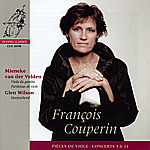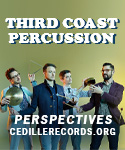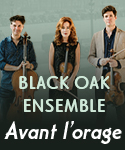While the availability of programs devoted to the chamber music of François Couperin have been relatively constant throughout the CD era, fans of the composer will find much to enjoy in rehearing these familiar works on this new Channel Classics offering. What immediately impresses is the recording’s sumptuous, remarkably illusionistic sound, with Mieneke van der Velden’s viols (a Pardessus de viole, the highest instrument in the gamba family, was chosen for the Onzieme [11th] concert from Les Goûts-Réunies) ideally complementing the scale of Glen Wilson’s harpsichord. There is none of the false intimacy created by overly close miking that often makes instruments sound larger than life, amplified, or disproportionate in their acoustic space. While this lovely natural setting certainly will appeal to audiophiles (who should know that this recording also is available on SACD), Couperin enthusiasts will equally delight in van der Velden and Wilson’s exemplary performances.
Opening and closing the program are Couperin’s final works, his two suites simply titled Pieces de Violes, famous for their excruciatingly heartfelt homage to tradition in the wake of Couperin’s witness (alongside Forqueray) to the death of the penultimate master of the instrument, Marin Marais (to whom van der Velden also has devoted a program on Channel Classics). While originally scored strictly for solo viol and continuo, these suites are rarely recorded that way–they often include an extra viol, such as in my two reference recordings performed by the Kuijken/Uemura/Kohnen ensemble on Accent and the Savall/Maurette/Koopman ensemble on Astrée. Van der Velden’s renderings not only are on par technically and stylistically with those performances, but she outright makes a case for the superfluity of the additional gamba’s aid. There are times when the spirit of play, of (typically Italian-influenced) improvisatory freedom, is enhanced by such extrovert invention, though given Couperin’s subject matter and source of inspiration here, this isn’t one of them.
Van der Velden’s performances of the previously mentioned Onzieme Concert and the Troisième (third) Concert from Couperin’s Concert Royaux are equally stunning. Listeners accustomed to hearing these works with the additional instrumentation may think the performances here to be somewhat undernourished. However, owing to van der Velden’s stunning virtuosity (especially with the delightful Pardessus de viole!) and inspired conceptions, the experience is analogous to enjoying both the deft simplicity of an old master drawing and a fine painting of the same period: both in their own way are equally enriching and satisfying. Highly recommended. [1/18/2003]
































